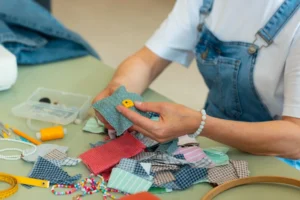Fashion is the largest polluting industry in the world, second only to the oil industry. The fashion industry alone can be conceived as responsible for 10% of the annual global carbon emissions and 20% of global water pollution. Fast fashion makes people feel old and outdated, encouraging them to purchase trendy items while producing low-quality, cheap garments that make people throw away more. As a result, tons of textiles are turned to waste, along with the resources that went into creating them.
Fortunately, customers are becoming more environmentally conscious, and the demand for sustainable apparel is increasing. Companies have introduced various technological innovations that can help improve the situation. Below, we will discuss a number of these creative alternatives to reduce fashion’s carbon footprint and this industry’s waste production.
Luxurious fashion shows that take place throughout the year give designers a platform to represent their finest work. However, these shows create tons of waste as designers showcase their skills. Moving these shows to an online venue will significantly decrease the amount of textile waste the fashion industry produces. If clothes are only made when a customer needs to purchase them, we will be able to prevent unnecessary production.
Additionally, technological advances like the metaverse or AR will facilitate online access to different clothing items, making the buyers’ decision-making process simple and straightforward. Customers can browse online shops and decide to buy something without the producer having to waste fabric to represent it in the real world. As a result, manufacturers can prevent excessive production of an item but meet consumer demand.

Alternative Material
Numerous organic materials can replace synthetic and environmentally hazardous substances used to make textiles.
- Hemp: hemp can be considered one of the fastest-growing plants used for industrial and medicinal purposes. Compared to cotton, it is more robust and needs less water. Hemp is resilient enough to be grown in almost any climate and requires no pesticides or fertilizers. Most importantly, hemp absorbs CO2, which makes it a carbon-negative material.
- Linen: organic linen is derived from a plant called flax. It is not as high-yielding as hemp, but it is equally sustainable. Linen is a popular choice, and growing it requires minimal amounts of pesticides, fertilizers, and irrigation.
- Cotton: organic cotton can grown without using chemicals and requires less water and resources than conventional cotton. Ethical cotton is picked responsibly, and farmers work under safe conditions receiving a fair wage.
- Bamboo: the plant itself is not chopped off when harvesting bamboo. Therefore, bamboo can quickly heal back to its original state after being collected. Similar to hemp, bamboo is among the fastest-growing plants and absorbs CO2. Bamboo can be a practical and functional alternative to plastic and can be used to manufacture various textiles.
- Cork: Quercus suber is an evergreen tree that is also commonly called the cork oak. Cork oak’s bark should be regularly harvested to extend its life, and luckily for us, that is how cork is made. This material is generally used to make vegan bags and shoes.
- Seaweed: sustainable seaweed fabric, as the title suggests, is made of a type of marine algae called seaweed. Seaweed is abundantly available and contains beneficial properties that protect the skin against a harsh environment. Therefore, it can be used to manufacture safety clothing like firefighter uniforms.
- Ramie: Ramie is a highly breathable fabric resembling silk and linen. The material is harvested from a flowering plant native to China and is often mixed with cotton to make the fabric more durable. However, customers should be wary of the type of ramie fabric they purchase since some are chemically processed and dyed.
Jute: Jute is a long soft fiber extracted from the bark of a plant with the same name. It is spun into threads that are biodegradable and completely environmentally friendly. It has a wide range of utilities across different industries, including fashion, where the fabric is turned into light clothing items
Eco-friendly Dyeing
Dyeing is the process of applying the desired color to textiles. Unfortunately, the conventional dyeing process often involves using chemical materials that harm the environment. The industrial method utilizes large amounts of water for this process which is then contaminated with pollutants. The wastewater that is discharged contains toxic substances that affect workers’ health. Additionally, the wastewater will adversely affect all life that comes into contact with it. Aquatic animals will die, the land becomes toxic, the crops grown in the neighboring lands may not be safe to consume, and light absorption will be increased, which diminishes algae’s photosynthetic activity. What makes algae important is that since they are positioned at the bottom of the food chain, their presence or lack of would severely affect the ecosystem.
Alternative dyeing techniques offer to return to a time before synthetic colors took over the fashion industry. Natural colors derived from plants, minerals, and insects can provide beautiful hues for our clothes. Organic dyes are usually biodegradable and have medicinal properties. Some are anti-bacterial and anti-fungi; therefore, they will protect the consumer’s body from diseases.
Although many eco-conscious companies are working on natural dyes, there is still a long way to go. One of the most critical factors is the manufacturing costs which can be immensely reduced by applying synthetic dyes instead of organic ones. Therefore, many companies are still inclined to do it the industrial way.
3D Printing
As sustainability drives more industries toward technological applications, it is time the fashion industry caught up. As an example, the use of 3D printing in fashion could result in a waste-free production process. Designers will be able to use the exact amount of fabric they need, eliminating cut-offs and scraps. Furthermore, 3D printing uses recycled material to design clothes and footwear. One such endeavor can be seen in Adidas’ use of plastic waste from the oceans to create shoes. In conclusion, 3D printing will make a difference in sustainable fashion, helping us use plastic responsibly and limit our waste production.

Lab-Created Gems
Mining gemstones is the next environmental concern that needs to be addressed by technology. Various gems of different colors can now be created in laboratories that are visually identical to natural gems at a third of the price. This method eliminates the need for mining which usually involves dangerous working conditions and, at times, child labor. We will no longer need to deplete our natural resources and leave pollutants behind. Moreover, lab-made gemstones have a lighter carbon footprint, and their production is entirely eco-friendly.
The Future of Sustainability in Fashion
Although sustainable fashion has made great strides with the help of these eco-conscious alternatives, there is still much room for improvement. Each of these solutions comes with many problems that leave something to be desired. For instance, alternative materials might not be able to replace animal skin or animal hair entirely. Furthermore, we must take time to educate people about alternative fabrics and how to purchase clothing responsibly.
Eco-friendly dyeing techniques might not produce as high-quality results as the conventional methods. It is challenging to retain color fastness and get particular shades using herbal dyes. Plus, switching to eco-friendly dyeing techniques is costly for manufacturers and disrupts their production.
3D printing is not widely available yet. This technology needs to become cheaper and more accessible to be considered a viable option for the sustainable fashion industry. Moreover, creating gemstones in a lab will render many miners unemployed. These people will have difficulty maintaining an acceptable standard of living. Miners demand that companies and governments implement improved mining standards instead of abandoning them and closing down their source of income. While these alternatives might seem to be the future of fashion, each one needs tinkering to be able to take over as the environmentally-friendly future of fashion.



